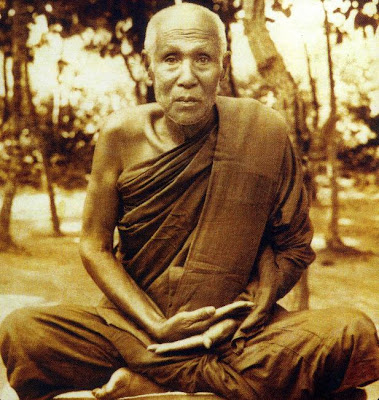According to the written accounts and legends that we obtained from the local communities, Luang Pu Kamphan acquired very powerful knowledge on the magical spell and supernatural techniques. He is regarded as the monk with the blessing from Naga (the dragon).
In those days when Luang Pu Kamphan carried out the sacred ceremony during making his sacred objects, villages used to notice there were colorful light bolts spinning above the Wat That Mahachai. It was a huge diameter circumference covering the center of the temple.
According to the novice and the monk who lives in the temple, they had always heard strange noise in the main hall of the temple. A few of the novices even noticed two Naga were kind of fooling around in the main hall. When they checked the main hall, they could notice colorless transparent sliver.
Luang Pu Kamphan is very well-verse on one of his Yant – the Mahapatana. Literately, Maha means “the greatest”; patana means “the dream will come true”. Thus Mahapatana means whatever you dream about or your wish, when you do this chanting, they will come through. According to our records, Luang Pu Kamphan was the only reverend in the whole Thailand who managed to master this Yant. There are 25 spells in this Yant. He is the only monk in Thailand who had reached the ultimate level – to be able to combine all 25 spells into a single symbol. He used the Mahapatana Yant in most of his sacred objects.
Luang Pu Kamphan once told his disciples “For those who own my Mahapatana, his dream will come true, he will never be haunted by hunger and poor”. I have seen several real cases on the power of his Mahapatana (including myself). I had encountered at least 5 success cases of Mahapatana; from the statistical point of view, the confident level is as high as 96.9%. I am now waiting for 2 more feedback, whom I know wearing the Mahapatana amulet. Rest assured, I have confident to get a positive feedback from them.
For the experiences, you are welcome to drop me an email: oseng_my@yahoo.com
Following are the sacred objects that he made.
Mahapatana 2nd Batch
Mahapatana 2nd batch
Mahapatana 2nd batch
Note: I will upload Mahapatana 1st batch very soon.
Phra Kring
Phra Kring
Phra Kring
Pidta
Pidta
Note: Please see how detail the Yant behind his pidta
Pidta - with the guarding of Naga
This monk is just awesome and his amulets have help a lot of people achieving a much better life; and I am one of those whom I feel lucky.
Below items are my personal collections:
Front - Praput Na Kaew (Left), Locket (Center) Uk Pak Kut (Right)
Back - Praput Na Kaew (Left), Locket (Center) Uk Pak Kut (Right)
Front - Rean Mahapatana, 1st Batch, 2530 B.E.
Back - Rean Mahapatana, 1st Batch, 2530 B.E.
Front - Rean Mahapatana, 2nd Batch, 2535 B.E.
Back - Rean Mahapatana, 2nd Batch, 2535 B.E.
Front - Pidta; Neu Wa (Left), Gem Stone (Center), Silver (Right)
Back - Pidta; Neu Wa (Left), Gem Stone (Center), Silver (Right)
The back of the Gem stone pidta is carved with mahapatana totum
Front - Pidta and Payanat
Back - Pidta and Payanat
Front - Pidta and Somdej
Back - Pidta and Somdej (With Mahapatana totum)


































